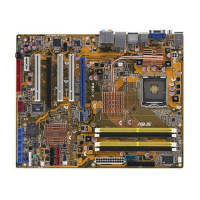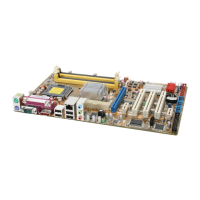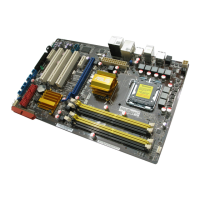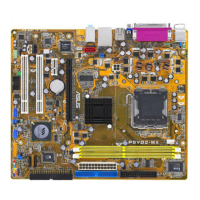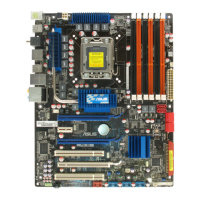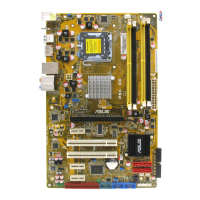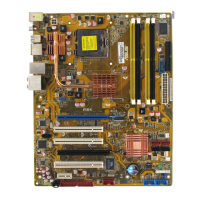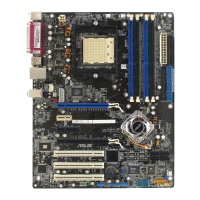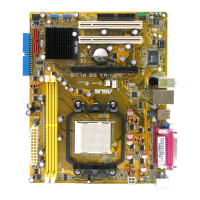
Do you have a question about the Asus P5K SE - Motherboard - ATX and is the answer not in the manual?
| Brand | Asus |
|---|---|
| Model | P5K SE - Motherboard - ATX |
| Category | Motherboard |
| Language | English |
Device compliance with FCC rules for RF emissions and interference.
Compliance with Canadian radio noise emissions regulations.
Guidelines to prevent electrical shock and damage during component handling.
Best practices for safe installation and handling of motherboard and components.
Explanation of the manual's chapter organization and content.
Links to ASUS websites and optional documentation for updates.
Explanation of symbols used for warnings, cautions, and notes.
Explanation of text formatting like bold, italics, and key notation.
Details on CPU socket, chipset, memory support, and expansion slots.
Specifications for storage interfaces, network, audio, and USB ports.
Features related to ASUS AI Lifestyle, exclusive overclocking, and rear panel connectors.
Lists internal connectors, BIOS features, manageability, support CD contents, and form factor.
Initial welcome message and list of items included in the motherboard package.
Introduction to the motherboard's unique features and technologies.
Detailed list of the motherboard's key features like CPU support, chipset, and memory.
Description of ASUS AI Lifestyle features for system stability and quiet operation.
Explanation of ASUS EZ DIY features for easy system setup and maintenance.
Features for CPU and memory overclocking and system performance tuning.
Safety precautions, system requirements before component installation, and onboard LED status.
Explanation of the motherboard's onboard standby power LED status.
Visual guide to motherboard layout, placement, screw holes, and component summary.
Instructions on orienting and securing the motherboard in the chassis.
List of slots, jumpers, and connectors on the motherboard.
Step-by-step guide for installing CPU, heatsink, and fan.
Detailed procedure for installing the CPU into the socket.
Guide for mounting and dismounting the CPU heatsink and fan assembly.
Information on memory types, configurations, QVL, and installation.
Details on DDR2 DIMM sockets, speeds, and configuration options.
Qualified Vendors List for DDR2 memory modules.
Procedures for installing and removing memory modules (DIMMs).
Details on expansion slots, installation, configuration, and interrupt assignments.
Steps for installing and setting up expansion cards.
Details on PCI, PCIe slots and IRQ assignments.
Configuration of motherboard jumpers for various functions.
Procedure to clear CMOS settings using the CLRTC jumper.
Jumpers for keyboard and USB wake-up functionality.
Description of rear panel and internal connectors for peripherals and devices.
Identification and function of rear panel I/O ports.
Identification and function of internal motherboard connectors for peripherals and devices.
Procedures and BIOS beep codes for initial system power-on.
Methods for safely turning off the system using OS functions or power switch.
Utilities and methods for updating the motherboard BIOS.
Covers various utilities for BIOS management, update, and recovery.
Steps to create a bootable floppy disk for DOS utilities.
How to enter and navigate the BIOS setup utility screens and elements.
Detailed settings across Main, Advanced, Power, Boot, Tools, and Exit menus.
Basic system information and SATA device configuration.
Advanced CPU, USB, Chipset, and device configuration options.
Power management features and system boot order settings.
BIOS security features and options for saving/discarding changes.
Accessing BIOS utilities for flashing and profile management.
Guidelines for installing operating systems and drivers for compatibility.
Information on drivers, utilities, manuals, and other software on the support CD.
How to launch the support CD interface and its main menus.
List of available device drivers and installation procedures.
List of included utilities like ASUS Update, PC Probe II, and AI Suite.
Details on ASUS MyLogo2, audio configurations, and other software.
Guide to customizing the boot logo using the ASUS MyLogo2 utility.
Configuration of audio settings, equalizer, mixer, and I/O.
Utility for monitoring system vital components and sensors.
Launching and using AI Suite utilities like AI Gear2, AI Nap, and Q-Fan 2.
Information and usage of Intel EM64T feature for 64-bit OS.
Guide to using EIST for CPU power management and performance.
Information and usage of Intel Hyper-Threading Technology.
